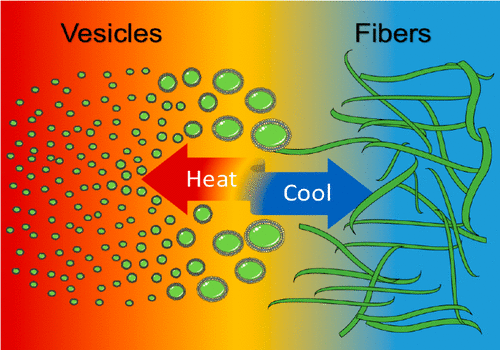当前位置:
X-MOL 学术
›
J. Phys. Chem. B
›
论文详情
Our official English website, www.x-mol.net, welcomes your feedback! (Note: you will need to create a separate account there.)
Temperature-Dependent Reversible Morphological Transformations in N-Oleoyl β-d-Galactopyranosylamine.
The Journal of Physical Chemistry B ( IF 3.3 ) Pub Date : 2020-05-21 , DOI: 10.1021/acs.jpcb.0c01410 Mai Johnson 1 , Ahanjit Bhattacharya 1 , Roberto J Brea 1 , Kira A Podolsky 1 , Neal K Devaraj 1
The Journal of Physical Chemistry B ( IF 3.3 ) Pub Date : 2020-05-21 , DOI: 10.1021/acs.jpcb.0c01410 Mai Johnson 1 , Ahanjit Bhattacharya 1 , Roberto J Brea 1 , Kira A Podolsky 1 , Neal K Devaraj 1
Affiliation

|
Amphiphilic molecules self-assemble into supramolecular structures of various sizes and morphologies depending on their molecular packing and external factors. Transformations between various self-assembled morphologies are a matter of great fundamental interest. Recently, we reported the discovery of a novel class of single-chain galactopyranosylamide amphiphiles that self-assemble to form vesicles in water. Here, we describe how the vesicles composed of the amphiphile N-oleoyl β-d-galactopyranosylamine (GOA) undergo a morphological transition to fibers consisting of mainly flat sheet-like structures. Moreover, we show that this transformation is reversible in a temperature-dependent manner. We used several optical microscopy and electron microscopy techniques, circular dichroism spectroscopy, small-angle X-ray scattering, and differential scanning calorimetry, to fully investigate and characterize the morphological transformations of GOA and provide a structural basis for such phenomena. These studies provide significant molecular insight into the structural polymorphism of sugar-based amphiphiles and foresee future applications in rational design of self-assembled materials.
中文翻译:

N-油酰 β-d-吡喃半乳糖胺中的温度依赖性可逆形态转变。
两亲分子根据其分子堆积和外部因素自组装成各种大小和形态的超分子结构。各种自组装形态之间的转换是一个非常重要的基本问题。最近,我们报道了一类新的单链吡喃半乳糖酰胺两亲物的发现,它们在水中自组装形成囊泡。在这里,我们描述了由两亲物N-油酰 β- d-吡喃半乳糖胺(GOA) 经历形态转变为主要由扁平片状结构组成的纤维。此外,我们表明这种转变以温度相关的方式是可逆的。我们使用多种光学显微镜和电子显微镜技术、圆二色光谱、小角 X 射线散射和差示扫描量热法,全面研究和表征GOA的形态变化,并为此类现象提供结构基础。这些研究为基于糖的两亲物的结构多态性提供了重要的分子见解,并预见了未来在自组装材料合理设计中的应用。
更新日期:2020-07-02
中文翻译:

N-油酰 β-d-吡喃半乳糖胺中的温度依赖性可逆形态转变。
两亲分子根据其分子堆积和外部因素自组装成各种大小和形态的超分子结构。各种自组装形态之间的转换是一个非常重要的基本问题。最近,我们报道了一类新的单链吡喃半乳糖酰胺两亲物的发现,它们在水中自组装形成囊泡。在这里,我们描述了由两亲物N-油酰 β- d-吡喃半乳糖胺(GOA) 经历形态转变为主要由扁平片状结构组成的纤维。此外,我们表明这种转变以温度相关的方式是可逆的。我们使用多种光学显微镜和电子显微镜技术、圆二色光谱、小角 X 射线散射和差示扫描量热法,全面研究和表征GOA的形态变化,并为此类现象提供结构基础。这些研究为基于糖的两亲物的结构多态性提供了重要的分子见解,并预见了未来在自组装材料合理设计中的应用。


























 京公网安备 11010802027423号
京公网安备 11010802027423号